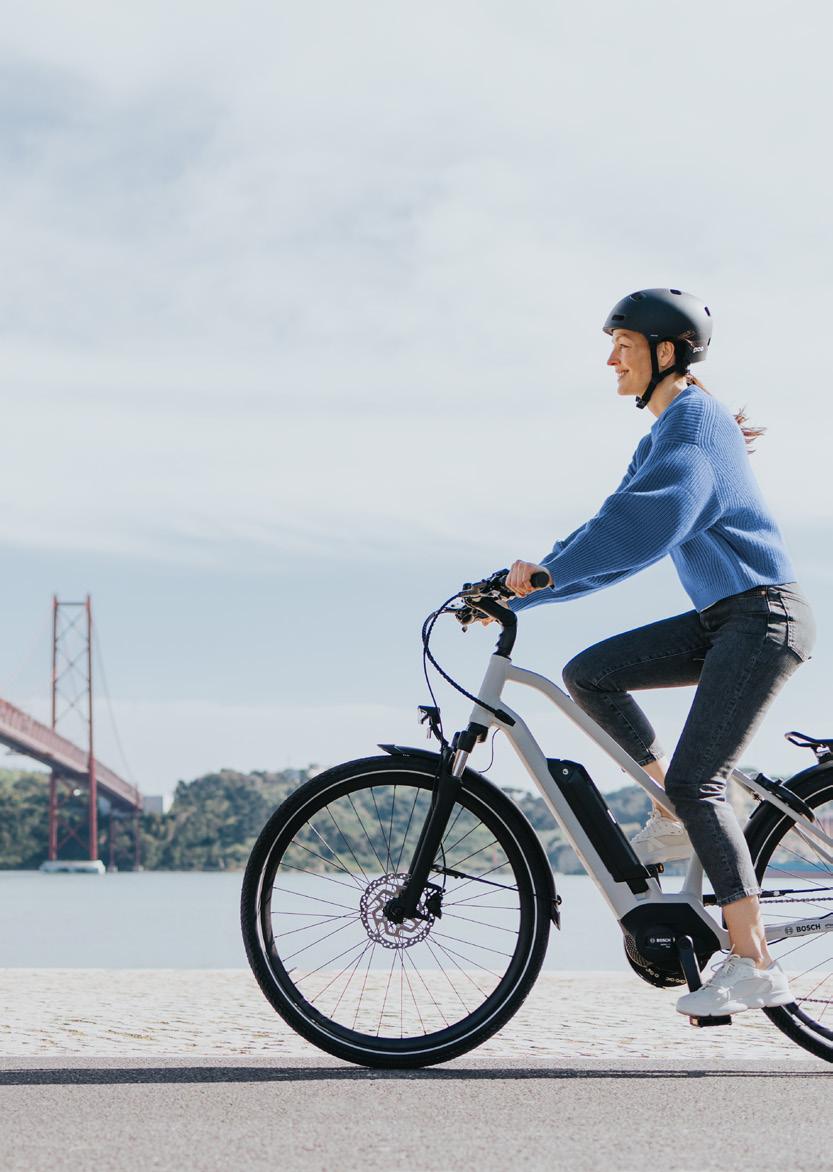

Your eBike Battery Guide
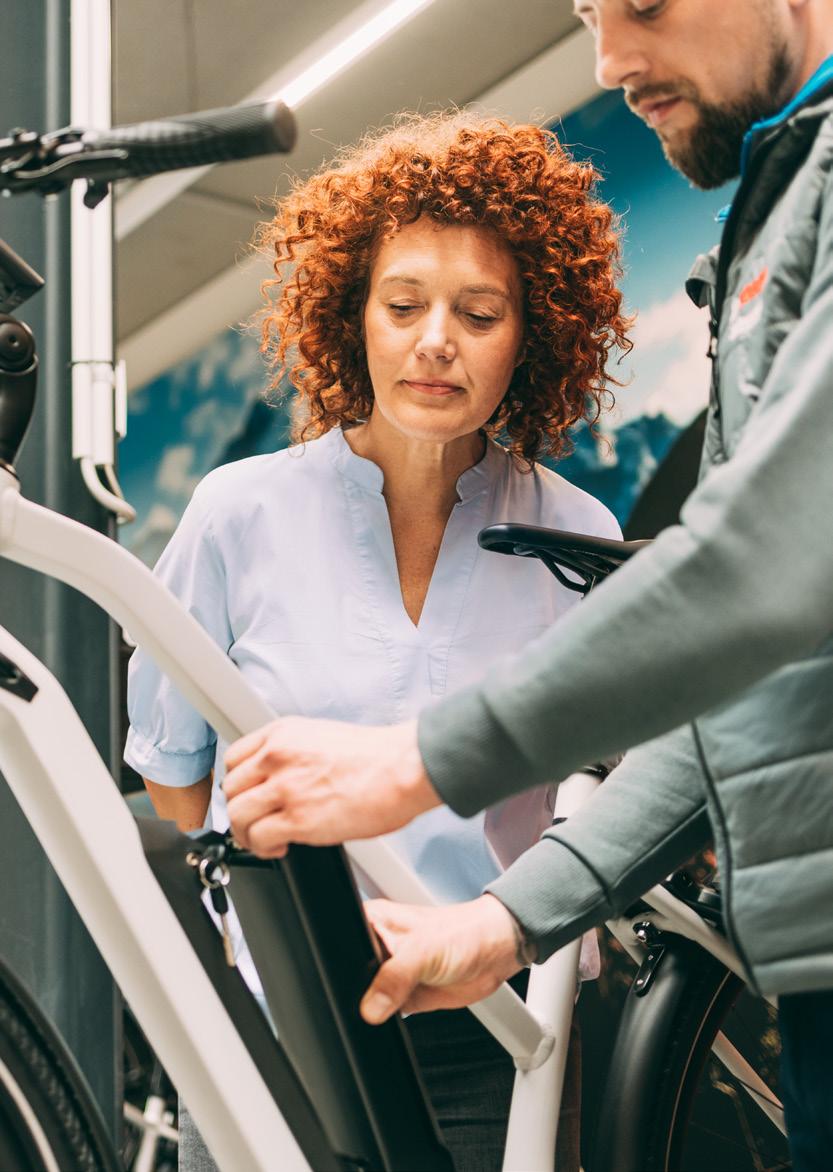
Do you have questions about eBike batteries?
We will familiarise you with the basics and show you how a battery works. We also explain how to charge, store and care for it correctly. If you follow a few tips regarding your battery, you will be safer on the road and will be able to rely on it for many years.

How does a lithium-ion battery work?
The lithium-ion technology in Bosch batteries stores energy efficiently and durably.
In this chapter you will find out how this works and why safety is particularly important with batteries.
Lithium-ion technology
Lithium-ion batteries from Bosch...
... are storage devices for electrical energy and supply your eBike with power.
... are rechargeable and can store a lot of electricity in an extremely compact space.
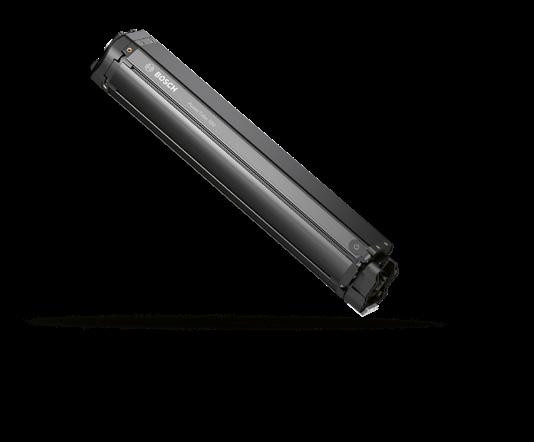
... last for many years and kilometres.
... are protected by an intelligent battery management system and are among the most modern on the market.
1 How does a lithium-ion battery work?
How is the power for your eBike generated?
A lithium-ion battery generates the electromotive force by displacing lithium ions. While the eBike is in motion and the battery is outputting energy electrodes move from the negative anode, via the consumer (e.g. drive unit), to the positive cathode. The lithium ions provide balance, thereby making the current flow. The reverse process takes place when the battery is charged.
Properties of lithium-ion batteries*
Benefits:
◾ Rechargeable
◾ Lots of energy in a compact space
◾ Lighter than other rechargeable batteries
◾ Quickly ready for use – even after long storage periods
Risks:
◾ Sensitive to overheating and short circuit
◾ Danger of gas leaks and risk of fire if damaged or incorrectly handled
* Compared to other battery types

How is a lithium-ion battery built?
The cathode typically consists of nickel, manganese, aluminium and cobalt-containing mixed oxides. The anode is made from graphite. The separator film prevents the two electrodes from directly contacting one another and therefore provides for protection against short circuits. Incidentally: The electrolyte is a conductive solution that transports the lithium ions between the cathode and the anode.
Positive pole
Negative pole
Cathode
Separator
Anode
Interesting facts
Capacity (charge and energy)
◾ The capacity is given in ampere-hours (Ah). It tells you how much power can be drawn from the battery and for how long.
◾ The amount of energy that can be stored, stated in watt hours (Wh), is the actual working capacity of the battery and is relevant for the achievable range.
Easy charging
◾ Whether full, half-full or empty, batteries with lithium-ion cells can be charged quickly, irrespective of their state of charge, at any time. Interruptions of the charging process do not harm the battery.
◾ A “memory effect”, i.e. decreasing capacity due to frequent incomplete discharge, as familiar from earlier battery systems, does not occur with lithium-ion batteries.
Extremely low self-discharge
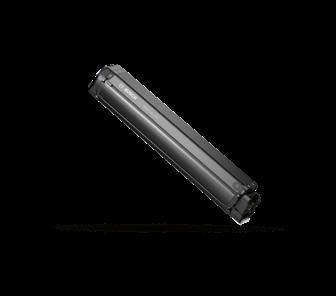
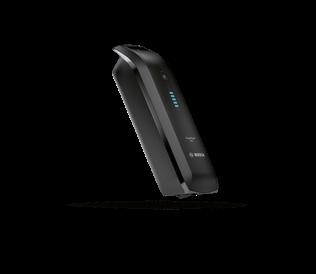
Even after long periods of storage, e.g. over winter, the battery can be used without recharging.
Service life
◾ Batteries are wearing parts. Even when not in use, they age over time due to chemical reactions in the battery cells. This is referred to as calendar ageing.
◾ The battery ages faster when exposed to high temperatures or when stored at low or high states of charge.
◾ The so-called cyclical ageing of the battery is caused by charging and discharging processes. The more intensively a battery is used, the faster it ages cyclically.
Bosch eBike batteries
Frame battery
Because it is a frame battery, the PowerPack is easy to access and remove. Thanks to its low centre of gravity, it ensures balanced weight distribution.
Rack battery
Thanks to their higher positioning on the eBike, rack batteries can be removed and charged conveniently while standing.
Integrated battery
The PowerTube integrates perfectly in the frame, creating an elegant, sleek eBike look.
Powerful in every design
Greater range
DualBattery
Combining two Bosch batteries provides considerably more energy and therefore more range.
Range extender
The additional drinking-bottle sized battery provides even more range as a portable energy reserve.
You would like to find out more about the various batteries from Bosch? Find the suitable lithium-ion battery for any requirement and for every eBike type: bosch-ebike.com/batteries
Battery safety
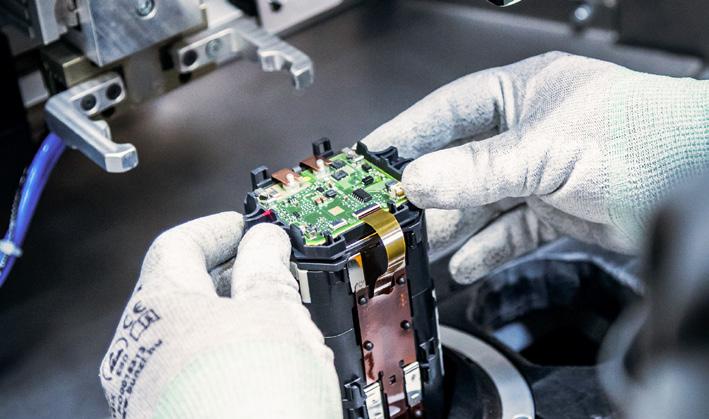
Lithium-ion batteries are complex in structure, have a high energy content and can cause danger as certain constituents are flammable. For this reason, eBike batteries must undergo extensive legally prescribed tests and may only be brought to market once they have passed these.
Bosch eBike Systems sets new standards in battery safety
Bosch eBike Systems goes above and beyond the strict legal requirements with certain tests and pays special attention to battery safety throughout the entire value chain.
Examples of safety measures*:
◾ Battery Management System (BMS)
◾ Mechanical isolation of battery cells
◾ Electrical isolation of battery cells
◾ Thermal isolation of battery cells
◾ Protection against water ingress
◾ Automation in production
Potential sources of danger are counteracted where they could arise. This significantly reduces the risk of an extremely rare emergency.
This battery housing must not be opened. This is exclusively reserved for competent persons after qualification and training. Opening the battery always means interfering with their certified condition and entails safety risks.
* Safety measures depending on design and generation
How Bosch technology makes batteries safer*
Battery Management System (BMS)
The intelligent BMS continuously monitors the condition of the battery. It detects potential fault sources and protects against excessive operating temperatures, overload and deep discharge. It checks every cell, extending the life of the battery.
Mechanical isolation of battery cells**
The individual cells of a Bosch eBike battery are encased in flame-retardant plastic.
Electrical isolation of battery cells**
An integrated fuse provides electrical interruption, in case of increased current flow from a cell.
Thermal isolation of battery cells**
The encased cells and additional separators reduce the risk of overheating in the battery and a potential thermal chain reaction between the individual cells. This enables a controlled process in the event of gas evolution in the battery: the gas is able to escape in a controlled manner via a predetermined breaking point, preventing it from spreading to further cells.
Protection against water ingress
The sealing concept of a Bosch eBike battery protects it against water ingress and therefore against consequential damage.
Automation in production**
A high degree of automation in battery production reduces the risk of assembly errors.
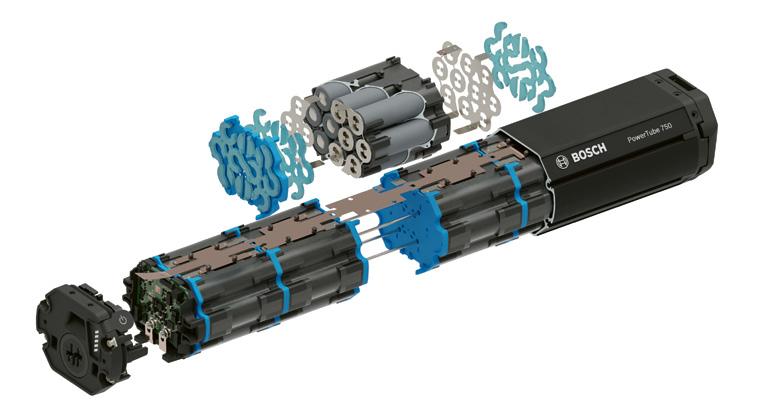
* Based on the example of a PowerTube 750
** Safety measures depending on design and generation
Structure of Bosch lithium-ion battery*
Basic rules for greater safety
1 2 3
Do not open. This is reserved for competent persons after qualification and training.
Protect from heat, sunlight and fire.
Do not immerse the battery in water, transport it on the rear bike rack of the car in the rain or clean it with a direct jet of water or high pressure cleaners.
4
5
Keep batteries away from small metal objects such as keys, nails or screws. There is a risk that contacts will be bridged, resulting in a short circuit.
Do not damage, e.g. due to hard shocks, sharp objects or screws.
How do I handle the battery correctly? 2
Batteries are highly complex components. If you follow simple rules for handling, care and transport, this will have a positive effect on the durability and safety of your battery –so you can enjoy your eBike for many years.
Charging

Chargers
The charger must match the battery: please only use compatible chargers for Bosch eBike batteries. This helps protect the battery from damage and prevents dangers such as overheating or short circuits. Original Bosch chargers are of course always compatible with Bosch eBike batteries.
2 How do I handle the battery correctly?
Charging facilities
◾ Charging on the eBike: As soon as you have plugged in the charging cable, the drive unit is automatically locked and the charging process begins. You don’t need to do anything else.
◾ Charge separately: If the battery can be removed for charging, it is important that you feel and hear it click into the mount when you reinsert it.
◾ Charging on the go: If there is no charging station on your route, our chargers are so compact and light that you can easily take them with you.

Tips for optimal charging
◾ Before charging: Check the battery for visible damage and allow it to cool down.
◾ Only charge fully if necessary.
◾ After charging: Disconnect the battery and charger from the power supply.
◾ Avoid emptying completely while riding.
◾ Do not charge in escape routes or on flammable surfaces.
◾ Do not charge near combustible materials.
◾ Do not leave the battery unattended when charging.
More information:
Only use compatible chargers for Bosch eBike batteries. With original Bosch chargers, you are always on the safe side.
Make sure the environment is dry and smoke detectors are present.
Charge the battery at an ambient temperature between 0 and 40 °C.
Avoid direct sunlight.
2 How do I handle
Storing
Where should the battery be stored?
◾ Store the battery in a dry place protected from the weather. Ideally in a well-ventilated room with a smoke detector, away from heat sources or highly flammable materials.
◾ Due to the cool temperatures, storing the battery in a basement or garage is better than storing it in living spaces.
◾ Remove the battery from the eBike if you are not going to use or store your eBike for a lengthy period of time.
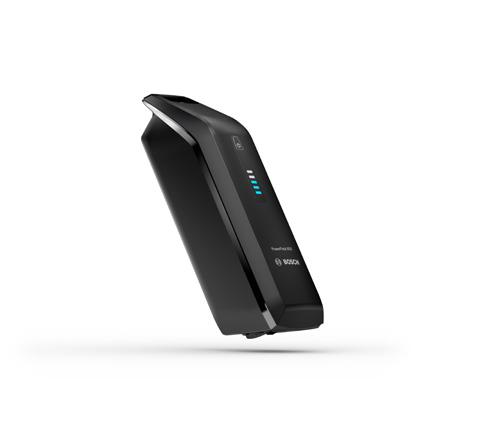
For storage, a charge level between 30 and 60% is ideal. This corresponds to 2 to 3 lit diodes on the battery display.
How should the battery be stored?
◾ Ideally, you should store your battery at temperatures between 0 and 20 °C in a dry environment or between 10 and 20 °C in a humid environment with dew formation.
◾ Avoid excessive heating and direct sunlight.
◾ Cold temperatures, such as those that can occur in a garage in winter, are harmless. However, a cold battery delivers less power.
◾ A charge level between 30 and 60% is ideal. This corresponds to 2 to 3 lit diodes on the battery display.
Care
Cleaning & care
◾ If possible, remove the battery before cleaning your eBike.
◾ Use a damp cloth to clean the surface of the battery.
◾ You should clean the plug poles occasionally and lightly grease them with technical Vaseline.
◾ To protect the electronics, you must not clean the battery with direct water jets or even high pressure cleaners.
Winter use
◾ If you store your battery in a garage: On particularly cold days, move it to a heated area and wait for it to warm up to room temperature before riding.
◾ For longer journeys in cold conditions, it is advisable to use thermal protective covers.
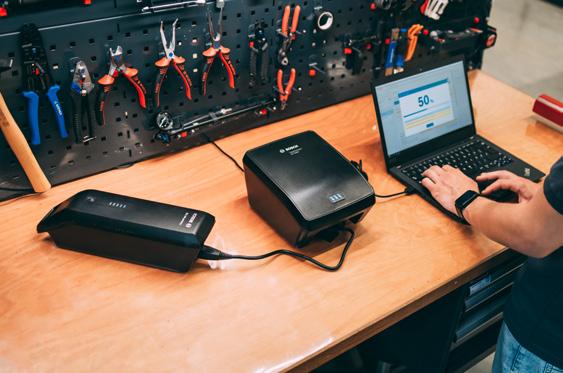
Regular inspection of your eBike by a specialist dealer is important! Here, the condition of your battery is checked professionally using various tools from Bosch eBike Systems.
2 How do I handle the battery correctly?
Transporting
Lithium-ion batteries store large amounts of energy. That’s why you should take some precautions during transport.
By car
If you are transporting your eBike outside of the car, e.g. on a car luggage rack, remove the on-board computer and battery if possible and store both safely in the car to avoid damage.
By train
You can usually easily take your eBike with you on trains with a bicycle compartment. You often need to get an extra bike ticket and make a reservation for the eBike. The battery must remain permanently installed during the journey and must not be charged. Before starting your journey, you should contact the respective service provider for precise information on the transport conditions. Please note that it may not be possible to take them on all routes.
On commuter services and long-distance buses
On commuter services, for example on light rail services, it is often permissible to take a bike on board at regional off-peak times, provided you have purchased a bicycle ticket. Before your trip, find out more details from the relevant transport authority. If you want to take your eBike with you on a coach, contact the relevant provider in advance.
Flights
Air transportation organisation IATA has forbidden the transportation of batteries on passenger planes. Depending on the airline, you may be able to take your eBike with you without a battery. We recommend renting a Bosch eBike battery at your destination.
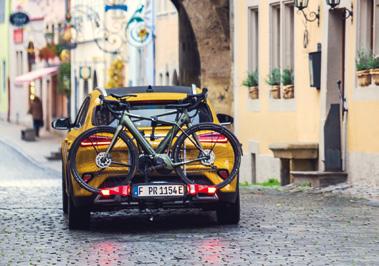
Safety on the go: It is best to transport the battery with a charge level of 30% and only charge it fully again at your destination.
Exchange instead of repair

All batteries lose capacity over time. eBike batteries are also wearing parts. For safety reasons, you should not repair or refresh faulty, old or worn out batteries, but have them recycled appropriately.
Risks attached to repairing or refreshing Bosch eBike batteries
To protect the battery cells, batteries are sealed against the ingress of water and dirt. Opening the battery and reassembling it improperly or incorrectly can lead to a loss of tightness and increased friction on wires, weakening of insulation, displacement of the battery cells, weakening of electrical or mechanical connections and countless further potential risks.
Correct function and optimum interaction with the Battery Management System may no longer be fully guaranteed if a battery is improperly repaired. There is then, among other things, a risk that the improperly repaired eBike battery will catch fire due to a short circuit.
Improper opening and repair can also have an impact on guarantee and warranty claims as well as on compliance with legal requirements (such as transport regulations).
2 How do I handle the battery correctly?
Recycling
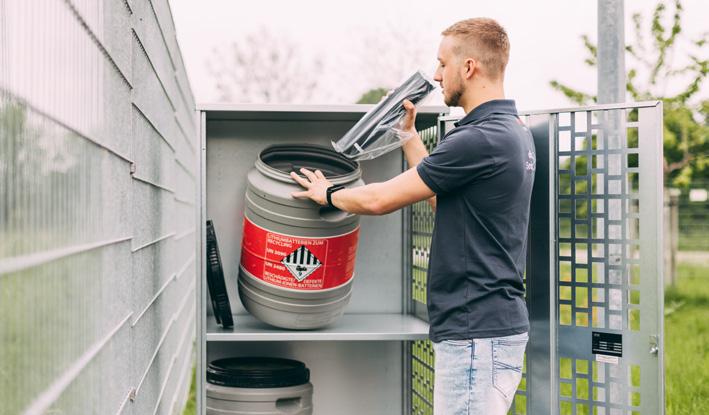
Your eBike battery does not belong in the household waste bin!
If disposed of improperly, the batteries may become mixed with other flammable materials. This can destroy the battery and cause dangerous short circuits.
So where should I bring the battery at the end of its lifetime?
Quite simple: Please contact your local council or recycling center.
Recover resources through recycling –this is how high the actual recycled content is
Percentage
Nearly 71% of the raw materials in a used eBike battery can be recovered and used for new products.
Source: Own representation based on GRS Batterien Service GmbH, Recyclingeffizienzen 2022, Germany
Incorrect use (second use)
Our batteries are specially designed and certified for use with eBikes. We cannot guarantee reliable operation in other application areas.
2 How do I handle the battery correctly?

Range assistant for more reliable planning
Calculate how many kilometres of support your eBike battery is likely to deliver on your next ride : bosch-ebike.com/range
How far can I ride with my eBike battery?
For many eBikers, this is a central question to which there is no definitive answer, as the range depends on many factors. Our range assistant tool makes it possible to estimate a typical range under various parameters.
In addition, the following graphic shows how the range changes, for example, if Turbo mode is selected rather than Eco mode:
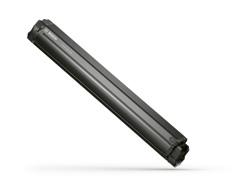
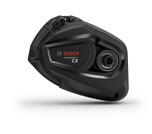
All figures are estimates.
3
Frequently asked questions and answers
What should I do if water gets into the battery mount?
The mount is designed in such a way that water can drain off and the contacts can dry. To ensure that this happens, the mount and plug area should be kept clean. The contacts are supplied with a coating which protects the surface against corrosion and wear. Technical Vaseline may also be used occasionally to maintain the contacts if required.
How do I deal with a defective battery?
Heavily damaged batteries should not be touched with bare hands as electrolyte may leak out, causing skin irritation. Damaged batteries are best stored in a safe place outdoors, protected from rain and direct sunlight and with the contacts taped, before being disposed of by a dealer.
Are chargers from other manufacturers safe to use?
Only if it is ensured that these are compatible with the Bosch eBike batteries. Bosch cannot make any statement about the safety of third-party devices. We generally recommend original spare parts from Bosch.
Can I use replacement batteries from other manufacturers?
Only if it is ensured that these are compatible with the Bosch eBike batteries. We generally recommend original spare parts from Bosch. These are always compatible with Bosch eBike batteries. Bosch eBike components are precisely matched and certified as a complete system. They stand for reliability and efficiency.
I have found a used battery for the Bosch eBike system online. Can I use this?
When purchasing used batteries, you must always make sure that they have not been damaged by their previous owner. Damaged or unprofessionally repaired batteries are offered online from time-to-time; these pose a possible high safety risk and can lead to dangerous malfunctions. Sometimes illegal or stolen goods are available online as well.
Bosch eBike battery check
If you buy a used battery, you can use the serial number to check whether a service case has already been registered for that battery. bosch-ebike.com/accu-check
Robert-Bosch-Platz 1
70839 Gerlingen-Schillerhöhe Germany
bosch-ebike.com boschebikesystems
